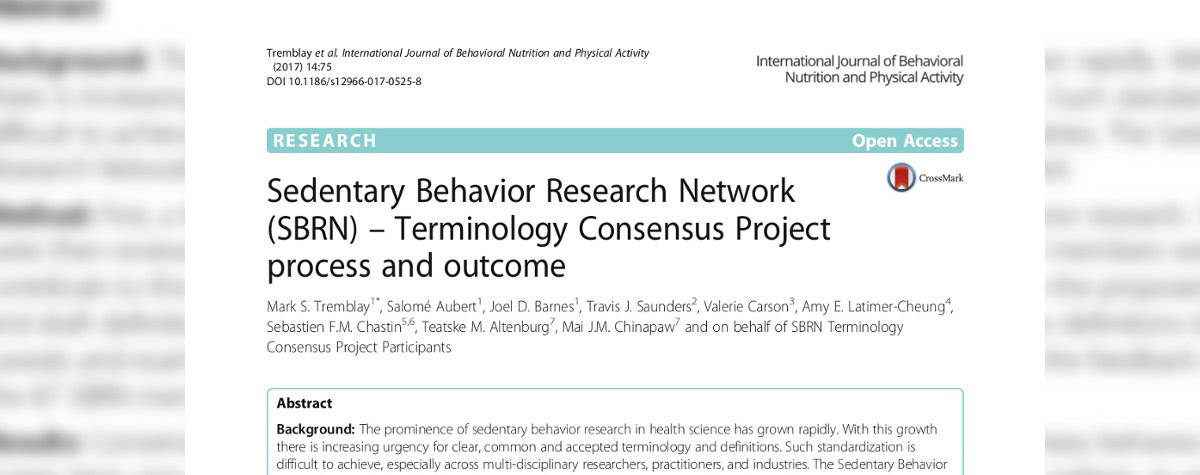
New textbook on sedentary behaviour and health
May 5, 2017
How do you define sedentary behaviour?
June 10, 2017OTTAWA, ON – June 10, 2017 – A worldwide network of scientists examining the links between sedentary lifestyles and health problems such as obesity and cardiovascular disease today announced a new dictionary of terms to support research into sedentary behaviour.
The results of the ‘terminology consensus project’ led by the Children’s Hospital of Eastern Ontario Research Institute’s (CHEO RI) Sedentary Behaviour Research Network (SBRN) are published today in the International Journal of Behavioral Nutrition and Physical Activity in a paper co-authored by 84 scientists from 20 countries.
“This is the world’s most extensive agreement to date on consensus definitions for researchers examining sedentary behaviour, an emerging global public health priority,” said lead author Dr. Mark Tremblay, director of the CHEO RI’s Healthy Active Living and Obesity Research Group (HALO) and a professor at the University of Ottawa. “There is an urgent need for clear, common and accepted terminology worldwide to facilitate the interpretation and comparison of research. We have made tremendous progress by defining terms such as physical inactivity, stationary behaviour, sedentary behaviour, and screen time. These terms have already been translated into several languages for rapid global uptake.”
The paper, entitled “Sedentary Behaviour Research Network: Terminology Consensus Project Process and Outcome”, provides refined definitions to suit all age groups, including babies, young children and people with chronic disease or mobility impairment. It also describes how bouts, breaks and interruptions should be defined and measured in the context of assessing sedentary behaviour and in relation to health outcomes.
The conceptual framework described in the paper also illustrates how both energy expenditure and posture are important components and how the terms relate to movement behaviours throughout a 24-hour period, including physical activity and sleep. Examples provided distinguish between active and passive sitting, active and passive standing, sedentary and stationary behaviour, screen time and non-screen-based sedentary time. Sedentary behaviour for a baby, for example, includes sitting in a car seat with minimal movement and, for a toddler, watching TV while sitting, reclining or lying down.
The 84 SBRN co-authors, which include researchers, trainees, graduate students, health practitioners and government employees, agree that standardization of the terminology is crucial to advancing future research, especially since this rapidly growing field of health science involves multi-disciplinary researchers, practitioners and industries.
“These consensus definitions will help scientists and practitioners navigate and understand the rapidly evolving field of sedentary behaviour research, allowing for more consistent and robust exploration of behaviours across 24 hours – sleep, sedentary behaviours and various intensities of physical activity – and may facilitate future research exploring ways to alter behaviours to improve health,” Dr. Tremblay said. “Our hope is that these will reduce confusion and advance research related to sedentary behaviour and, ultimately, promote healthy active living.”
Dr. Tremblay will chair a discussion of the project’s findings at a workshop today at the International Society of Behavioral Nutrition and Physical Activity annual meeting in Victoria, British Columbia. Consensus definitions have been translated into French, Spanish, Portuguese, Dutch, Korean, German, Greek, Traditional Chinese, and Japanese.
About SBRN
The SBRN, based at the CHEO RI, was established in 2011 as an initiative born out of the HALO research group and is the only organization for researchers and health professionals which focuses specifically on the health impact of sedentary behaviour. Its mission is to connect sedentary behaviour researchers working in all fields of study and to disseminate related research. As of March 2017, it had 1,273 members in 35 countries. Membership is free and open to any researcher or health professional with an interest in sedentary behaviour (see www.sedentarybehaviour.org).
The Healthy Active Living and Obesity Research Group (HALO) at the CHEO RI was established in 2007 in response to the escalating obesity crisis and the increasing complexity of related co-morbidities. Today the HALO team consists of 17 staff (including 5 scientists), a childhood obesity clinical team (Centre for Healthy Active Living), 16 graduate students, trainees, undergraduate students, and many community volunteers. For more information, visit www.haloresearch.ca or @HALOresearch
About CHEO Research Institute
The CHEO Research Institute coordinates the research activities of the Children’s Hospital of Eastern Ontario (CHEO) and is affiliated with the University of Ottawa. Its three programs of research include molecular biomedicine, health information technology, and evidence to practice research. Key themes include cancer, diabetes, obesity, mental health, emergency medicine, musculoskeletal health, electronic health information and privacy, and genetics of rare disease. The CHEO Research Institute makes discoveries today for healthier kids tomorrow. For more information, visit www.cheori.org or @CHEOhospital
Media contact:
Adrienne Vienneau
CHEO Research Institute
Direct: 613-737-7600 x4144
Cell: 613-513-8437
Email: avienneau@cheo.on.ca




